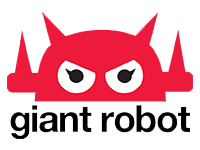Giant Robot Store and GR2 News
I’ve just returned from another expedition to the disaster-stricken Tōhoku coast and wanted to fill you in on this latest trip. (GR has published earlier reports for anyone interested!) This is the seventh time I’ve made the Tōhoku run since the March 11th quake and, as with previous excursions, I return to Tokyo depleted but also moved and humbled by the experience.
My mission this time was to load up my brother-in-law Kazu’s kebab-mobile in Onagawa and rendezvous in Kesennuma with Eiko Mizuno Gray and the Rainbow Cinema team, a motley crew of volunteers screening films (generously provided by Warners, Fox, Toho, Asmik, and other distributors) for quake survivors in the various shelters up north. The idea was for Kazu and me to provide free fresh kebab and ice cream to viewers during the breaks, while Eiko and her crew would keep the audience stoked during the screenings with their two popcorn machines (salt and caramel, respectively).
Onagawa, my in-laws’ home town was also hit hard by the quake and tsunami, with well over a thousand residents confirmed dead, several hundred still missing, and, according to a recent tally, about 1,200 living in shelters or temporary housing. So the morning before our deployment I had a walk around Onagawa, to see what progress had been made since my last visit a month ago. The whole port area is enveloped in a haze of fishy-smelling dust, but, to be honest, I couldn’t see much clear evidence of improvement. Yes, cranes are demolishing and clearing non-stop, and convoys of trucks haul debris to sorted piles (mountains, really); paths have been cut into the wreckage around the port, and many of the lightweight items (cars, refrigerators, bicycles, propane tanks) seem to have been gathered up. Nonetheless, the clean-up still appears quite superficial, just peeling away at the skin of an onion. A big-ass onion. Enough said.
This current trip comes on the heels of a very belated two-weeks of chilling out at my parents’ home in Hermosa Beach (my first visit to the U.S. in well over a year). And what a strange contrast: The coastal villages I drove through on my way up to the far north of Miyagi Prefecture were once not so different from some SoCal beach towns; and yet to look at them now, you’d never know it.
I was meaning to take the inland route all the way up to Kesennuma, but a wrong turn off the Sanriku Expressway took us straight into downtown hell, ground zero of the tsunami. Shizugawa, Minami Sanrikucho, Koganezawa, and many other little towns that line this particular stretch of Route 45, grew up around river deltas and estuaries, their common geographical feature being a mountain-fed river spilling into the ocean at the mouth of a valley. Seeing the now-familiar pattern of destruction repeated in each of these depopulated port villages, one imagines a wall of black water roaring up the mouth of the valley, erasing everything in it’s path. Imagine turning a corner to see that coming at you! You actually can’t even see the ocean from many of the spots the tsunami hit.
I’d been to Shizugawa and Minami Sanrikucho in the first days following the quake, had stood at the back of the valley looking down on the tsunami’s aftermath, still steaming fresh; impossible to forget the sight of a classroom full of children pried from the wreckage and placed in boxes (boxes for heads, boxes for torsos, hands, etc.). Even now, over a hundred days since the tsunami, the record of what happened is unmistakable. Debris in every possible configuration fills low-lying spots, and the tsunami waterline is in plain sight everywhere one looks. The transition between Unharmed and Obliterated is absurdly drastic. (It was, in fact, quite maddening to contemplate what a difference just a couple meters of elevation might have made at many locations.)
What follows is a brief report on the most recent of my trips to the disaster-afflicted areas in Tōhoku. Refer to my GR piece about the four trips I took to the North during the first month of the disaster.
 As I reported previously, Kazu, my brother-in-law in Onagawa, and I had devised an (admittedly vague) guerilla-style plan to distribute doner kebab, pita sandwiches, and possibly ice cream to those in need. Typically, Kazu drives his truck into Sendai and sells pita sandwiches as o-bento lunch for office workers there, and he recently augmented his truck with a Dairy Queen-type ice cream maker to entice local customers. (Though Sendai is a good-sized metropolis, Onagawa is a small fishing town, and kebab considered quite exotic there.) Obviously, the Tōhoku disaster brought business to a screeching halt. With no electricity to power the refrigeration at home, and no petrol for the truck or generator, Kazu had given away all his remaining stock to survivors the first day after the quake and tsunami, and the truck had sat idle in his backyard since. So, we envisioned, I’d re-supply him with fresh ingredients (meat, veggies, pita, yogurt, and ice cream) and he’d give away hot meals to folks living in the refugee centers. Or something like that. You hear about kids in the early days of Japan’s occupation, now in their seventies, fondly recalling the taste of chocolate and bubble gum given them by GIs; perhaps a generation of kids will grow up in Tōhoku with similar memories of their first kebab.
As I reported previously, Kazu, my brother-in-law in Onagawa, and I had devised an (admittedly vague) guerilla-style plan to distribute doner kebab, pita sandwiches, and possibly ice cream to those in need. Typically, Kazu drives his truck into Sendai and sells pita sandwiches as o-bento lunch for office workers there, and he recently augmented his truck with a Dairy Queen-type ice cream maker to entice local customers. (Though Sendai is a good-sized metropolis, Onagawa is a small fishing town, and kebab considered quite exotic there.) Obviously, the Tōhoku disaster brought business to a screeching halt. With no electricity to power the refrigeration at home, and no petrol for the truck or generator, Kazu had given away all his remaining stock to survivors the first day after the quake and tsunami, and the truck had sat idle in his backyard since. So, we envisioned, I’d re-supply him with fresh ingredients (meat, veggies, pita, yogurt, and ice cream) and he’d give away hot meals to folks living in the refugee centers. Or something like that. You hear about kids in the early days of Japan’s occupation, now in their seventies, fondly recalling the taste of chocolate and bubble gum given them by GIs; perhaps a generation of kids will grow up in Tōhoku with similar memories of their first kebab.
And, after all, who doesn’t like a good ice cream cone?
 First task: acquiring 60kg of Australian topside beef in 5mm slices, and 3kg each of minced lamb and beef. Lack of power, and brownouts in some dairy-producing parts of Japan have made yogurt scarce as well (I’d recently heard about a friend’s wife outsmarting supermarket restrictions on dairy purchases by lining up in disguise). And, then, several kilos of fresh cabbage and tomatoes. Issaku, owner of my favorite Tokyo izekaya, had the meat delivered to me on ice (no point trying to cram that much into my fridge); and Mo, a brother-in-law living in Tokyo, collected requisite yogurt and vegetables. So far, so good. I also agreed to give a ride up north to Gome, a young rapper and skateboarder whose best friend was 3rd AD on my second feature, and who’d lost touch with his family in Onagawa. During the drive north Gome would keep us alert with his hip-hop demos.
First task: acquiring 60kg of Australian topside beef in 5mm slices, and 3kg each of minced lamb and beef. Lack of power, and brownouts in some dairy-producing parts of Japan have made yogurt scarce as well (I’d recently heard about a friend’s wife outsmarting supermarket restrictions on dairy purchases by lining up in disguise). And, then, several kilos of fresh cabbage and tomatoes. Issaku, owner of my favorite Tokyo izekaya, had the meat delivered to me on ice (no point trying to cram that much into my fridge); and Mo, a brother-in-law living in Tokyo, collected requisite yogurt and vegetables. So far, so good. I also agreed to give a ride up north to Gome, a young rapper and skateboarder whose best friend was 3rd AD on my second feature, and who’d lost touch with his family in Onagawa. During the drive north Gome would keep us alert with his hip-hop demos.
 I rented a 6-seater van (called, delightfully I thought, a “Bongo“) the day before setting out and rode out to Asakusa-bashi to stock up with relief supplies at Second Harvest Japan, the food bank for which I’d already made a couple relief runs to the North. Charles McJilton, director of Second Harvest, loaded me up with about 300 bananas, 40 cases of fig cookies (donated by the French), and several boxes of canned fruit, and gave me a target: a school doubling as a refugee camp in Natori City, en route to Onagawa. But Charles also warned me that a couple drivers had recently been turned away at their destinations. Multiple governmental and non-governmental organizations are now supplying the North, but unavoidable overlap and, alternately, poor coverage in the various towns and villages affected have resulted in some points oversupplied, while others still lack the basics. Meanwhile, national and local bureaucratic controls have tightened, making it difficult for many grass-roots volunteer parties to get through. So, I told Charles, I’d stop off in Natori and see if they’d take the supplies, but if not needed there, I’d continue north and locate an alternate beneficiary in Ishinomaki or Onagawa, my ultimate destinations.
I rented a 6-seater van (called, delightfully I thought, a “Bongo“) the day before setting out and rode out to Asakusa-bashi to stock up with relief supplies at Second Harvest Japan, the food bank for which I’d already made a couple relief runs to the North. Charles McJilton, director of Second Harvest, loaded me up with about 300 bananas, 40 cases of fig cookies (donated by the French), and several boxes of canned fruit, and gave me a target: a school doubling as a refugee camp in Natori City, en route to Onagawa. But Charles also warned me that a couple drivers had recently been turned away at their destinations. Multiple governmental and non-governmental organizations are now supplying the North, but unavoidable overlap and, alternately, poor coverage in the various towns and villages affected have resulted in some points oversupplied, while others still lack the basics. Meanwhile, national and local bureaucratic controls have tightened, making it difficult for many grass-roots volunteer parties to get through. So, I told Charles, I’d stop off in Natori and see if they’d take the supplies, but if not needed there, I’d continue north and locate an alternate beneficiary in Ishinomaki or Onagawa, my ultimate destinations.
We set off from my flat at 5:30 AM on April 14th and made good time getting up into Miyagi Prefecture, stopping a few times along the way to top off the Bongo’s gas tank (but, I have to admit, blasting through Fukushima Pref. without stopping). We got off the Tōhoku Expressway for our stop in Natori, but the only official we managed to meet at our target, Natori Fujigaoka Primary School, having been newly dragooned from her usual post in Kyōto, was unfamiliar with local procedures and unable to direct us towards any appropriate facilities. We’d read some recent newspaper headline about shortages in Onagawa, so we decided to continue on, lest our cargo spoil.










